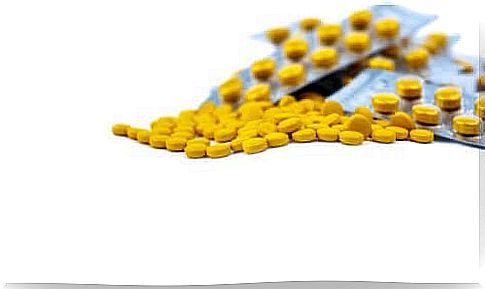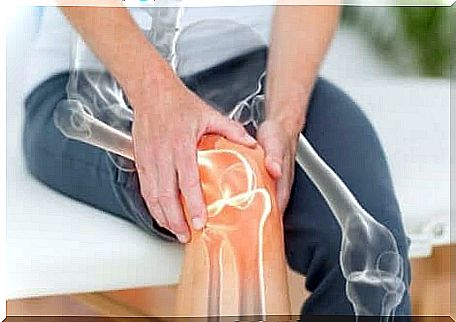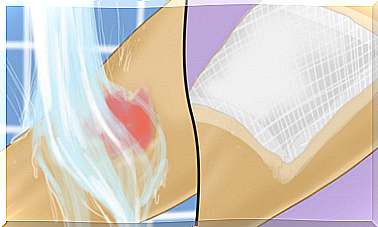Voltarene (diclofenac): Uses And Effects
Like all existing medicines, diclofenac is not free from side effects. The best known and most common is that of gastric ulcers, produced by its continued use, due to the inhibition of prostaglandin synthesis.

Voltarene is the trademark of an active ingredient known as diclofenac. An active ingredient is a chemical substance that triggers an effect on the body. Thus, diclofenac is a drug that belongs to the family of NSAIDs or nonsteroidal anti-inflammatory drugs.
This drug is indicated to reduce inflammation and treat pain, that is to say the same pathologies as the rest of the drugs in its chemical category. An example of its use is the reduction of menstrual colic.
Other indications for diclofenac are various rheumatic diseases, which we will see a little later, gout attacks and kidney stones.
We are now going to tell you about some of the indications of Voltarene in order to better understand its effects on the body.
What is the effect of Voltarene on the body?

Voltarene or diclofenac is a phenylacetic derivative which has a mechanism of action similar to that of other NSAIDs. However, as with the latter, this mechanism is not 100% known.
It appears to involve the inhibition of certain enzymes known as cyclooxygenases. Cyclooxygenase or COX is an enzyme that allows the body to synthesize substances called prostaglandins from another chemical, arachidonic acid.
However, the mechanism of action of diclofenac may also be linked to the inhibition of the synthesis of prostaglandins, which are substances participating in inflammatory responses and stimulating pain nerve endings.
Thus, diclofenac works by inhibiting cyclooxygenase and thus the production of prostaglandins to ultimately reduce pain and inflammation.
Moreover, these substances also have another series of functions, such as that consisting in maintaining the integrity and proliferation of the gastric mucosa, because they ensure good blood supply to it.
This mucous membrane takes care of protecting the stomach from irritants or microorganisms. So, since this synthesis of prostaglandins is inhibited, the gastric mucosa becomes vulnerable and that is why these drugs can trigger peptic ulcer.
Rheumatoid arthritis and Voltarene
Besides fighting menstrual colic, this drug is widely used for arthritic diseases. Rheumatoid arthritis is a chronic inflammatory disorder, which mainly affects the joints.
In some people, this disorder can damage different parts of the body, in addition to the joints, such as the skin, eyes, or lungs. Rheumatoid arthritis is an autoimmune disorder that occurs when the immune system mistakenly attacks tissues in the body, triggering episodes of pain and inflammation.
Voltarene, thanks to its anti-inflammatory and analgesic capacity, is thus able to reduce the symptoms of this disease.
What is osteoarthritis?

This is another rheumatic disease for which Voltarene is used. Unlike rheumatoid arthritis, osteoarthritis only affects the joints and not other parts of the body. It is the most common type of arthritis.
This disease damages the cartilage in the joints. The bone therefore ceases to have protection against brushing against other bones and these begin to collide directly. This friction causes pain, inflammation, and loss of movement in the joint.
Over time, the joint usually loses its normal appearance. Bone cracks may appear or additional bone growths around the edges of the joint. In addition, some structures in the joint may become detached, causing more pain.
What about ankylosing spondylitis?
This is another indication for Voltarene. It is a rheumatic disease that causes inflammation of the joints of the spine and the sacroiliacs. It usually manifests through frames of pain in the lumbar area of the back, which can extend to the entire spine and peripheral joints.
Ankylosing spondylitis can be accompanied by extra-articular symptoms such as inflammation in the eyes or in the valves of the heart.
The cause of this disease is still unknown today, but it has been linked to genetic factors. In addition, it affects men more than women and often occurs during adolescence or early adulthood.
Adverse reactions to diclofenac

Like all medicines, diclofenac is not free from side effects. As we have already mentioned, the best known and most frequent is that of gastric ulcers, produced by its continued use, due to the inhibition of the synthesis of prostaglandins.
However, other undesirable effects are linked to the administration of this anti-inflammatory. Among these we can mention:
- Alterations in the intestinal tract: nausea and vomiting, diarrhea or gas.
- Central nervous system: headache, dizziness, dizziness.
- Sensory organs: blurred vision or taste alterations.
- Skin: rash or hives.
- Kidney problems.
- Hemodynamic alterations.
- Allergic reactions.
Conclusion
Voltarene is a drug subject to medical prescription, indicated to reduce inflammatory frames and severe pain. It can be administered orally or topically as a cream.
Always follow the doctor’s directions as improper use of this medication can cause serious damage to the gastric mucosa and other side effects.









